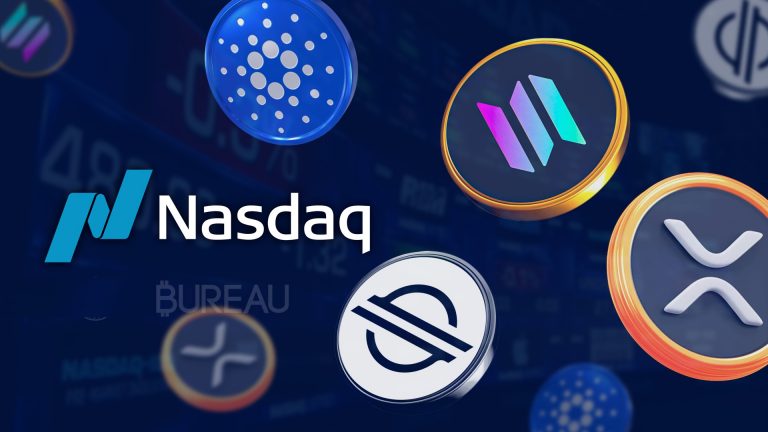
NASDAQ filed a proposed rule change with the SEC on June 2, 2025, to expand its Nasdaq Crypto Index (NCI) by adding Solana (SOL), Ripple (XRP), Cardano (ADA), and Stellar Lumens (XLM) alongside the existing Bitcoin (BTC), Ethereum (ETH), Chainlink (LINK), Litecoin (LTC), and Uniswap (UNI). This aims to make the index, which serves as the benchmark for the Hashdex Nasdaq Crypto Index US ETF (NCIQ), more reflective of the broader crypto market.
Currently, the ETF is restricted to holding only BTC and ETH due to SEC regulations, using a sampling strategy to approximate the index’s performance, which introduces tracking error risks. The SEC’s decision is expected by November 2, 2025. If approved, the ETF could invest in all nine assets, enhancing diversification and potentially boosting institutional interest in these altcoins. @MerlijnTrader on June 7, 2025, claim the SEC has already approved the updated Nasdaq Crypto US Settlement Price Index (NCIUS) including these altcoins, citing strong liquidity and reliable pricing.
However, this claim conflicts with multiple sources indicating the SEC’s decision is still pending until November 2, 2025. Given the inconsistency, the approval status remains inconclusive without official SEC confirmation. The inclusion of Solana (SOL), Ripple (XRP), Cardano (ADA), and Stellar Lumens (XLM) in the Nasdaq Crypto Index (NCI) has significant implications for the crypto market, institutional investment, and regulatory landscape. Adding SOL, XRP, ADA, and XLM to the NCI signals growing acceptance of altcoins beyond Bitcoin (BTC) and Ethereum (ETH) in mainstream finance.
Register for Tekedia Mini-MBA edition 19 (Feb 9 – May 2, 2026): big discounts for early bird.
Tekedia AI in Business Masterclass opens registrations.
Join Tekedia Capital Syndicate and co-invest in great global startups.
Register for Tekedia AI Lab: From Technical Design to Deployment (next edition begins Jan 24 2026).
This could attract institutional investors seeking diversified exposure to digital assets, as the NCI now covers ~78% of the crypto market cap, up from 64%. Inclusion in a Nasdaq index enhances visibility and trading liquidity for these altcoins, potentially reducing volatility and fostering price stability, as seen with BTC and ETH after ETF approvals. If the SEC approves Nasdaq’s proposal by November 2, 2025, the Hashdex Nasdaq Crypto Index US ETF (NCIQ) could hold all nine assets in the NCI, reducing tracking errors and aligning the ETF more closely with the broader crypto market.
This could set a precedent for multi-asset crypto ETFs in the U.S., reports suggest immediate market reactions, with SOL, ADA, XLM, and XRP seeing price surges (e.g., SOL +8.2% to $166, XRP +7.1% to $2.30) after the June 2025 filing announcement, driven by expectations of institutional inflows. The proposal fuels speculation about an “altcoin season,” where these assets could outperform BTC and ETH, as hinted by BlackRock’s recent shift from BTC to ETH holdings.
Nasdaq’s involvement may strengthen ties between crypto and tech-heavy stock indices, increasing correlations and potentially amplifying market movements. The filing tests the SEC’s willingness to embrace altcoins, especially after its cautious approach to non-BTC/ETH assets. Approval could signal a shift toward broader crypto acceptance, particularly post-Ripple’s 2023 legal victory and a pro-crypto regulatory environment under new U.S. leadership.
Approval may align U.S. crypto ETFs with more crypto-friendly jurisdictions, encouraging global adoption of multi-asset ETFs and boosting on-chain activities like staking and DeFi. XRP for cross-border payments, SOL for scalable smart contracts, ADA for research-driven blockchain, and XLM for low-cost global transactions. Their inclusion validates these use cases, potentially driving adoption in their respective niches.
Large players like BlackRock and Fidelity may favor the diversification, as it reduces risk and aligns with growing demand for altcoin exposure. Approval could trigger similar filings from major asset managers, as noted by Bloomberg’s James Seyffart. Some retail investors, particularly BTC and ETH “maxis,” express concern that altcoin inclusion dilutes the dominance of these primary assets. X posts highlight fears that BTC and ETH may lose their “unfair advantage” as altcoins gain legitimacy.
Industry analysts and X users believe the SEC’s potential approval, especially under a pro-crypto administration, could pave the way for more ETF approvals (e.g., for AVAX, DOGE, or TRUMP). Others caution that the SEC’s historical caution, as noted by Chair Gary Gensler, may delay or limit approval, especially given unresolved issues like XRP’s securities status. Conflicting X posts (e.g., @MerlijnTrader claiming approval vs. reports stating a pending decision) reflect uncertainty.
Limited to BTC and ETH ETFs, U.S. investors may benefit from diversified exposure if approved, but face delays due to SEC scrutiny. Jurisdictions like Brazil, where Hashdex already launched an XRP ETF, are ahead in offering altcoin products, creating a divide in access to diversified crypto investments. The Nasdaq’s proposal to include SOL, XRP, ADA, and XLM in the NCI is a pivotal step toward mainstreaming altcoins, promising increased institutional adoption, liquidity, and market stability.
However, it creates a divide between institutional and retail investors, BTC/ETH maxis and altcoin advocates, regulatory optimists and skeptics, and U.S. versus global markets. The SEC’s decision by November 2, 2025, will be critical in determining whether this move bridges or widens these gaps. Stakeholders should monitor price movements, public comments, and regulatory updates to navigate emerging opportunities.



